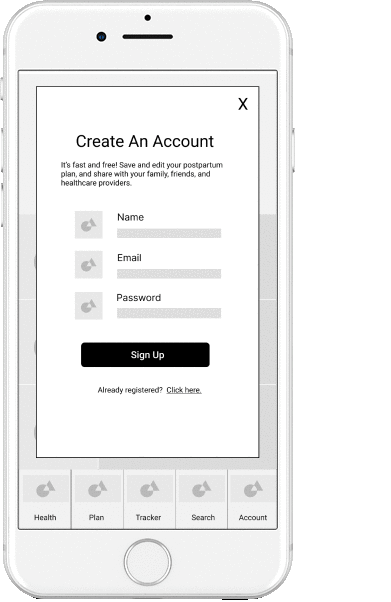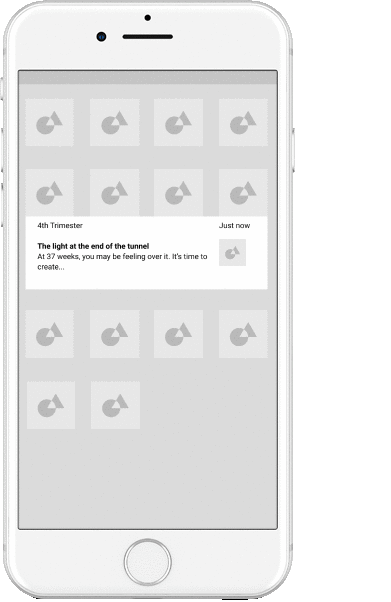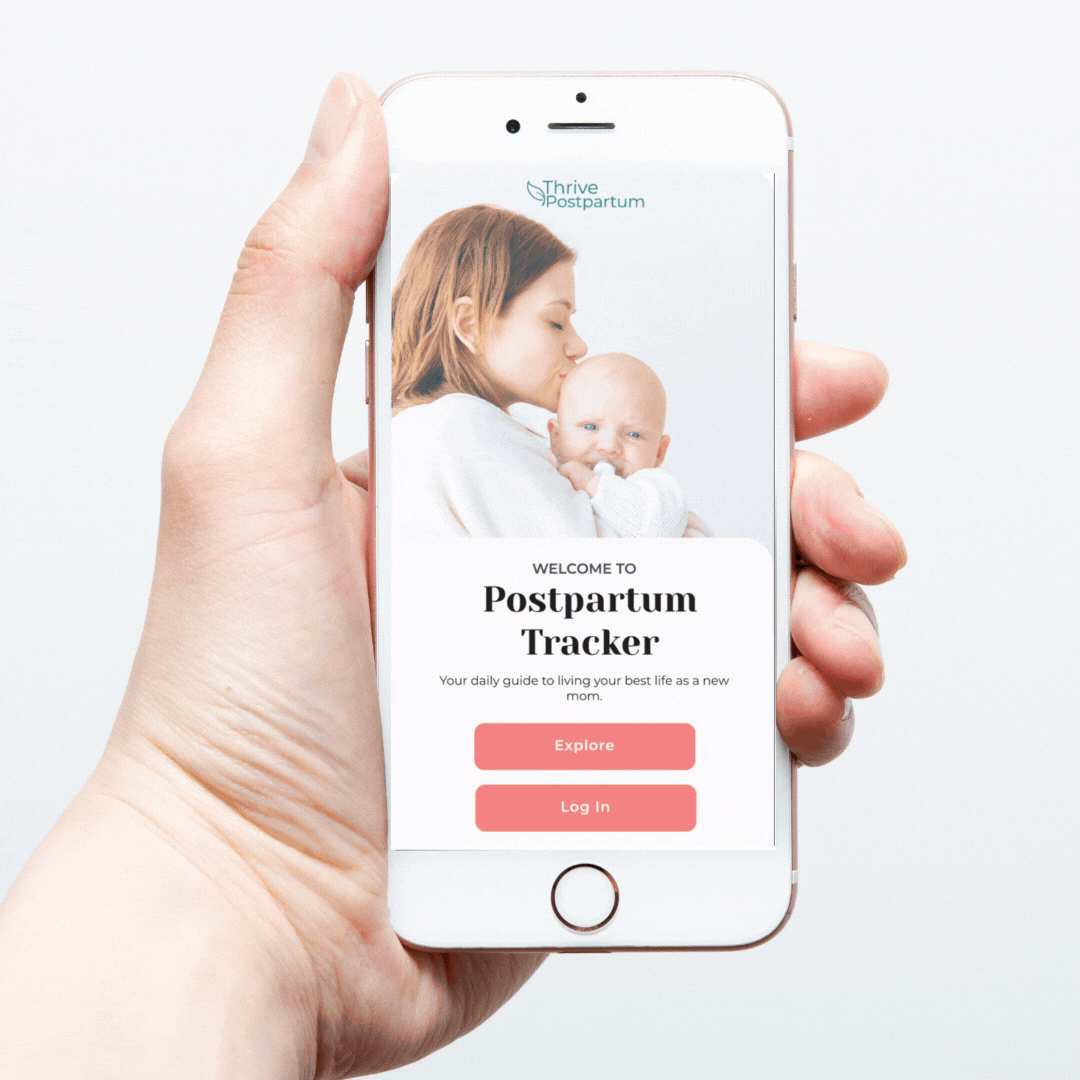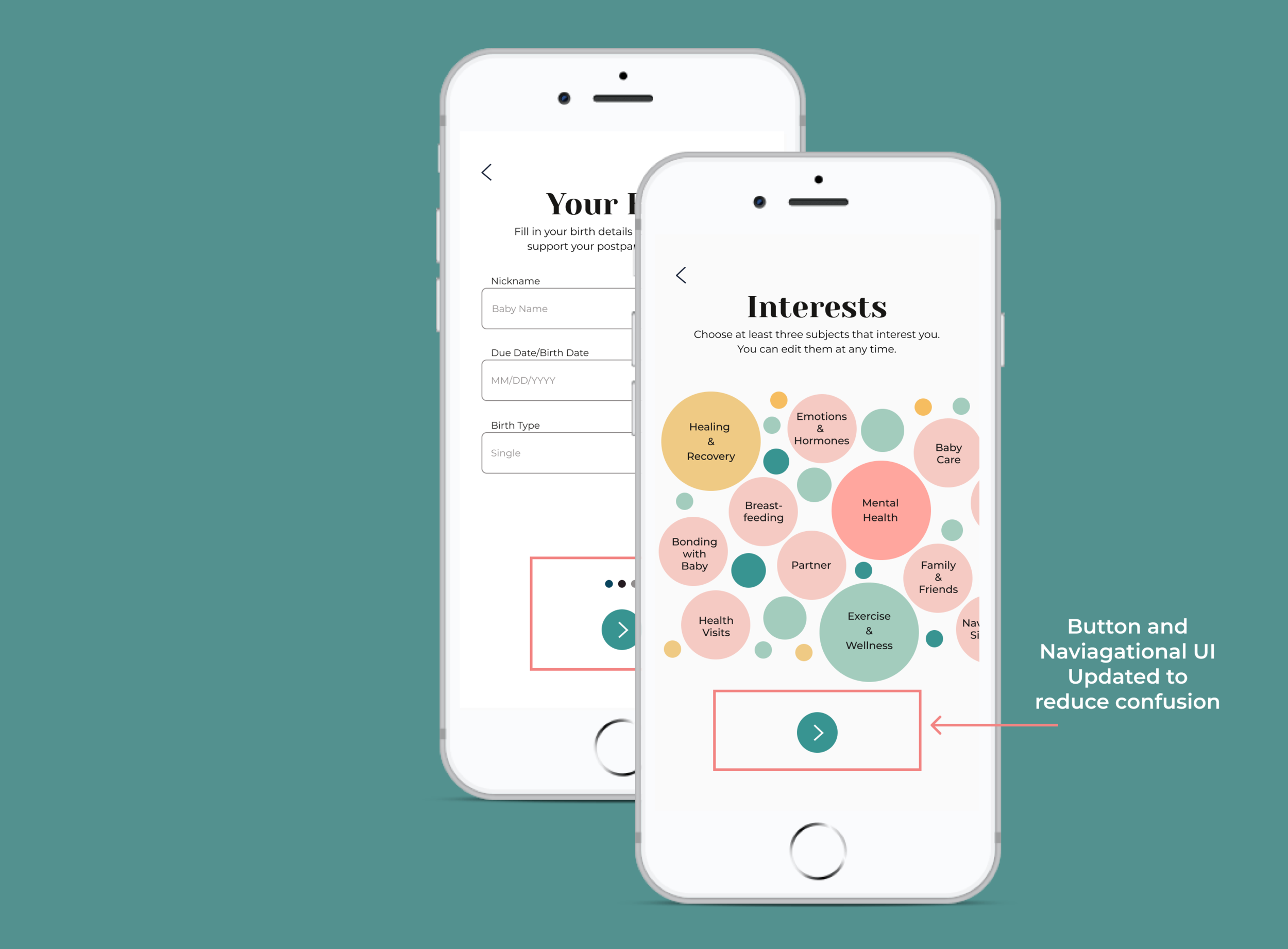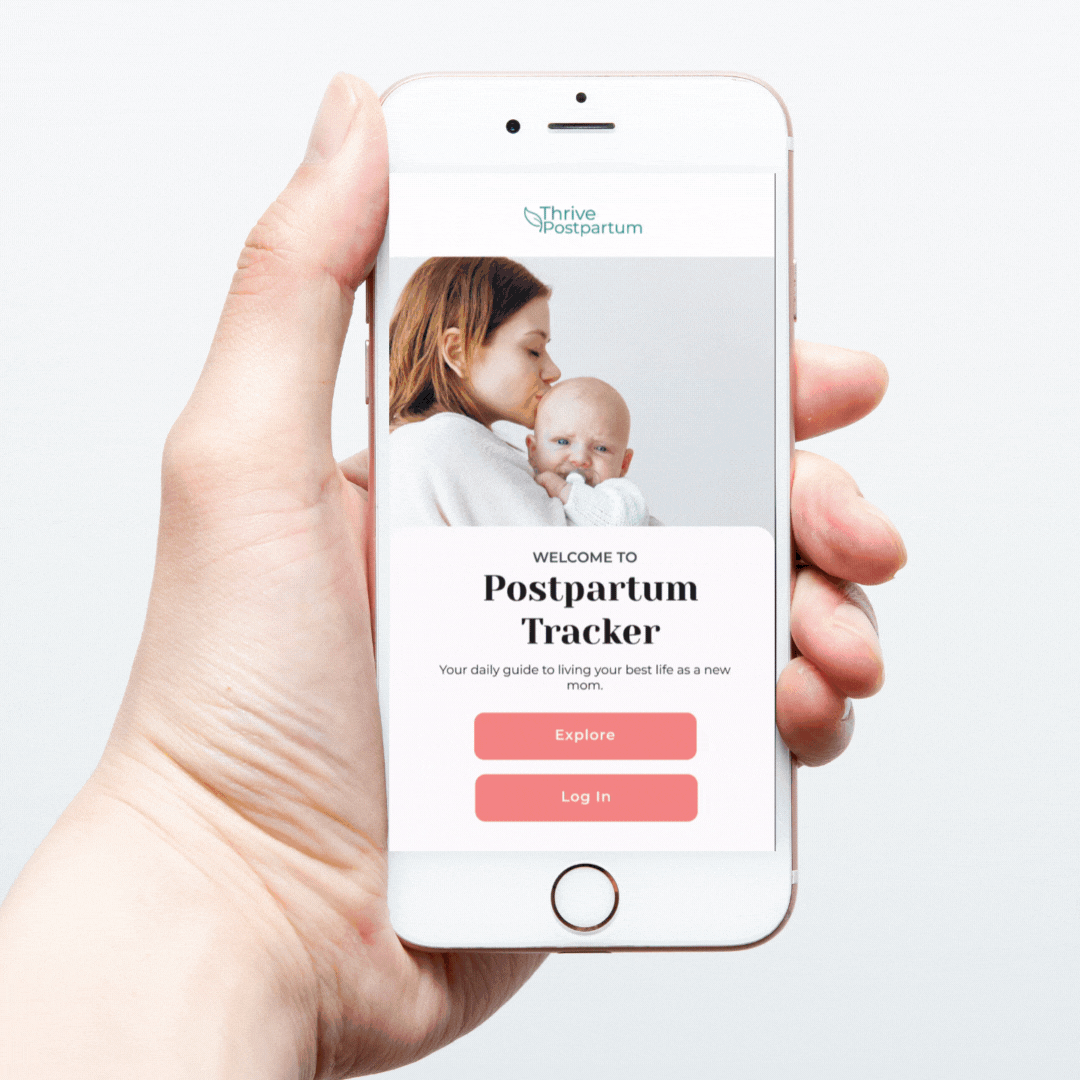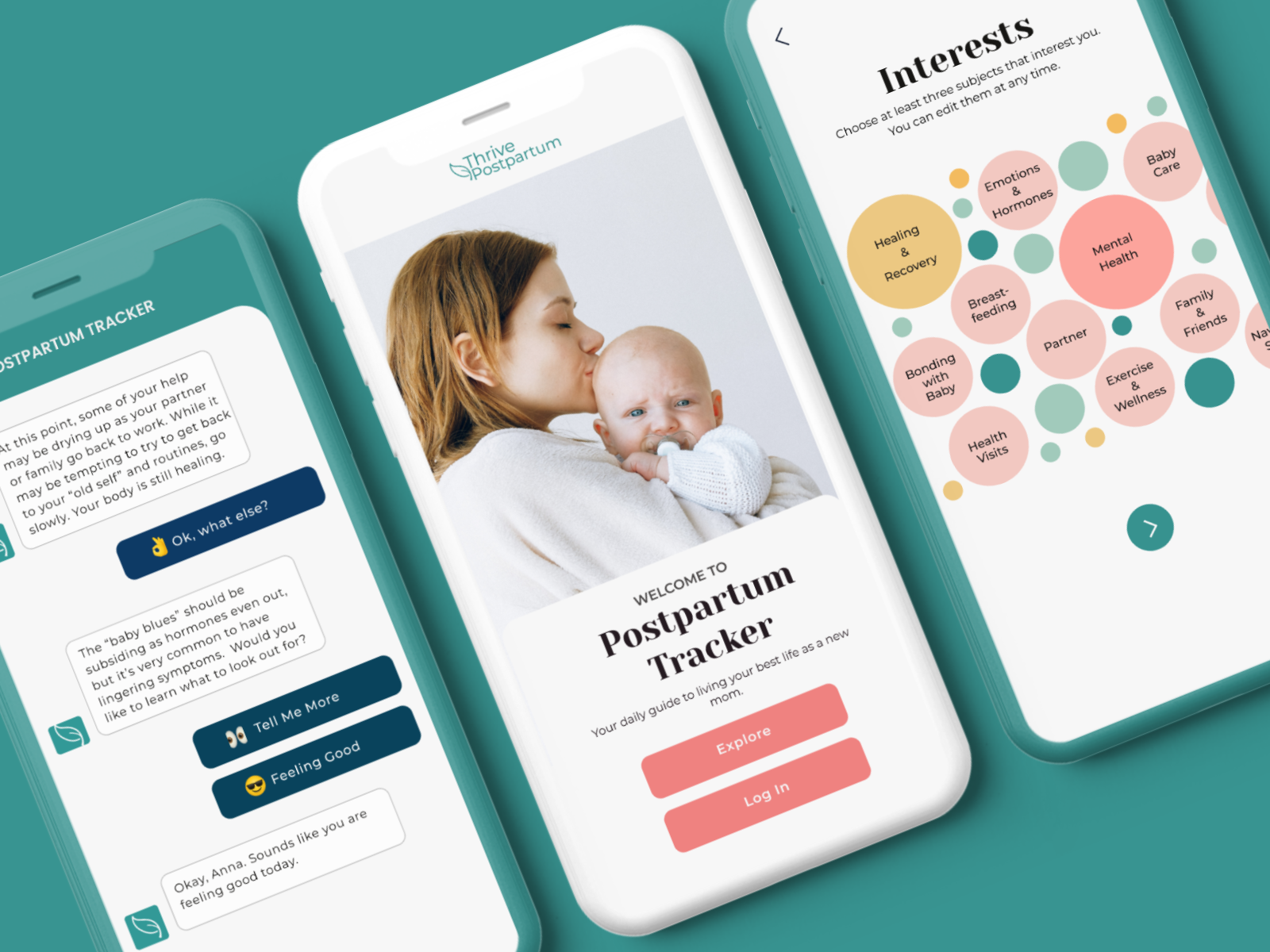
The 4th Trimester:
How Improving Education and Support Decreases Mental Health Issues in New Parents
Support for Mothers Drops Sharply Postpartum
During pregnancy and after birth, new parents are bombarded with advice and resources regarding the health and well-being of their new baby, but care and support for the mother ends abruptly at the perinatal period.
Untreated mental and physical issues may continue far into the future in as many as 38% of women yet there are no current global protocols for continued screening and care of these issues beyond the 6-week wellness checkup.
How might we help new parents, mothers in particular, feel prepared, educated, and supported during the fourth trimester?
75% of users say the 4th trimester is fraught with challenges
Over 70 participants in 3 countries answered a series of questions in order to assess user experience during the postpartum period. The results revealed that 75% of parents experience feelings of overwhelm, loss and isolation, exacerbated by physical and mental health challenges.
The issues are compounded for first-time parents, as veteran mothers and fathers can better anticipate needs and potentially offset some of the challenges with education, planning and additional resources.
The 4th Trimester presents many physical and mental challenges to new parents’ health, according research from the Journal of Perinatal Medicine, the Journal of Behavioral Medicine, and the Maternal and Child Health Journal.
So, What Do New Moms Need?
Meet Lauren and Kate.
Out of our research came two distinct personas: The first-time mother, Lauren, and the veteran mom, Kate.
While some of their basic postpartum needs overlap, we found key differences in the experience of first-time versus veteran mothers, specifically in how they plan for birth, their priorities planning for the postpartum period and how they advocate for themselves with loved ones and outside resources after baby comes home.
It was important that we keep these two experiences in mind as we designed in order to not leave out any of their needs.
Lauren Metz, 30
Lauren has been married for a little over two years and lives with her husband in a suburban area outside a major city. A teacher, Lauren is now 8 months pregnant with her first child.
She is currently on maternity leave but does not know if she wants to go back to work after the baby is born. She is close to her family and friends, yet she can’t find always find the resources and support she needs. It seems everyone has an opinion, from her doctor to her mother-in-law, and it’s hard to know who to believe.
Lauren’s Drive:
Prepare the best she can for life post-baby by educating herself
Learn what to expect from healing and recovery
Find a source of information she can trust -- everyone has an opinion but it is difficult for her to know what’s true
Worries about making mistakes or not doing the right thing
Kate Torres, 36
Kate is a married mom of a 2-year-old son, and pregnant with her second. She works in tech and lives in a large urban area with her family. Her extended family and closest friends live a plane ride away. Kate is planning on taking an extended maternity leave for baby #2.
Kate is a seasoned mother going through her second pregnancy/postpartum period, who knows what she can expect physically and mentally and wants to improve upon her last experience, which was much more difficult than she had expected. She had complications post-birth and ended up with a combination of postpartum depression and anxiety, which took months to diagnose and treat.
She doesn’t have a lot of physical support from friends and family, and relies on her husband for help around the house. She is dedicated to her job and her own interests and wants to find balance. She is not afraid to advocate for herself with her healthcare team and while she does go online for answers, she is more likely to target specific mom groups or medical websites to find answers. She is planning on hiring help at home.
Kate’s Drive:
Improve upon her last postpartum experience in general
Find outside help and support since she doesn’t have a strong support system where she lives
Find ways to support her own mental health and self-care
Interested in tips on handling issues with work-life balance and the mental load
Creating a Solution by Focusing on Pain Points
To address the key needs of Lauren and Kate, our focus was on addressing the main pain points they encounter:
Lack of preparedness
Isolation
Physical/mental support
We also wanted to find a way to bring partners and/or supporters into the postpartum process, as a practical way to alleviate some of the pressure most women express having experienced postpartum.
Initial Sketches & Guerilla Testing
In the first sketches, We illustrated the priority red routes, made up of the following screens :
A main dashboard page with custom content
A Postpartum Plan that could be filled in and shared with healthcare professionals, family and supporters
A Resources section to find professionals and support groups
A Postpartum Daily Tracker to send automatic, personalized tips and inspirational content to the user
Creating a Postpartum Plan
The user can fill in all of the details of her postpartum plan — from her personal information, medical team, and hospital wishes, to how she wants the first days home to play out.
Personalized Dashboard Content
Lauren and Kate can personalize the content that is presented to them in their very own week-by-week dashboard.
Daily Support via Chatbot
The user signs up for a tracker alert that will send her daily notifications in a “chatbot” format, with bespoke information and support based on her interests and needs.
Guerilla Testing Identifies Problem Areas
We decided to do a rapid round of guerilla testing with a group of 5 mothers at the playground in order to test my first ideas before committing to a digital mock-up.
Very quickly realized there were issues with the postpartum plan functionality. The in-depth questionnaire was overwhelming to the user, especially on mobile devices.
While enthusiastic about the concept of having an app that provides postpartum support, Lauren and Kate struggled to identify the main functionality and the value of completing this section.
Distilling the Scope Through Wireframes
Working through the issues spotted by testers, we clarified the red routes through the wireframe design, hypothesizing that if we created a postpartum plan questionnaire-style, instead of filling in personal information, the user hesitation and fatigue experienced previously would be ameliorated.
Create a Postpartum Plan
Personalize Your Dashboard
Sign up for Daily Notifications
Too Many Features Confuse Lauren & Kate
As we worked on different iterations, we began to realize that perhaps the scope of the product was unrealistic.
Too many functionalities confused Lauren and Kate, and muddled the value of the end product. They did not know where to focus, and the benefits of the app were lost.
The difficult decision was made to pare down the scope to the MVP, which became the Daily Postpartum Tracker notifications. The Dashboard and Share features would work to support the Tracker notifications and offer additional value to the user through customized content.
“Share” in particular would work to bring partners and other supporters into the postpartum experience by inviting these individuals to sign up for their own version of the app, where they would access personalized content designed to prompt them to check in with the new mother in their lives, providing tangible ideas on how to support her physically and mentally.
The dashboard-plus-tracker combination addresses the main pain points of preparedness, education, and isolation. At a point in the future, the more healthcare-related functionalities of the postpartum plan and resources bank could be added, once the product’s value has been established to its user base.
Designing a Better Postpartum
Our aim was to create a bright, modern and friendly design that would speak to Lauren and Kate in a way not currently seen in other womens health apps. We chose a color scheme that was feminine without being twee, and used illustrations depicting diverse women to remain inclusive.
Our design creates a personalized experience through an interactive onboarding page, a bespoke dashboard updated weekly, and a daily tracker “chat”.
Users can personalize their dashboard, read exclusive content tailored to their stage of the postpartum period, and receive daily updates via a chat bot to help them feel educated, supported and prepared in their journey.
Room For Improvement: User Hesitation in Key Areas
Five participants were recruited for remote, moderated usability testing on the prototype. Users were both men and women, identified as parents and smartphone users who downloaded apps at least occasionally.
User response was mostly positive, but we were surprised to see hesitation and confusion within our main navigational elements.
Four main issues were identified:
Problem #1: Navigation to Tracker
Users had difficulty navigating to the Tracker chat from the Dashboard.
Solution: Labels were added to the main navigation icons, and we included a push from the Dashboard for easy access to the Tracker Chat of the day.
Problem #2: The Navigation in the Account Section was Confusing.
Users hesitated when looking for the correct button.
Solution: The status bar, buttons, and fields were updated, with extemporaneous UI elements removed.
Problem #3: The Share functionality of the app was not understood.
Users asked if they were sharing content or their profile, not inviting their supporters to sign up for the app experience.
Solution: We worked on clarifying the text throughout the app, changing “Share” to “Invite”, and adding explanatory text. A ready-made generic body text to the invite page was also added to both expedite sharing and inform Lauren & Kate of its purpose.
Problem #4: Tracker Chat Functionality Lacked Expected Interaction.
Testing uncovered a desire to decline a certain subject prompt, or to skip to the next chat topic.
Solution: Incorporating a two-button response allows users to have a more interactive, personalized experience with the app, while still keeping the main functionalities intact.
Final prototype walkthrough, showing main red route.
Final design array shows principle UI
The Result?
Our Product Gives Lauren & Kate the Support They Need… But More Improvements to Come
A second round of testing showed major improvements in navigation and comprehension of the key functionalities of the app; however, further improvements could be made in improving “Invite” and “Tracker” visibility, perhaps through exploring ways to incorporate them more directly into an onboarding experience.
In the meantime, the end product has achieved our goals of providing education and support for new parents going through the postpartum period in an attractive, engaging, and inclusive way.








